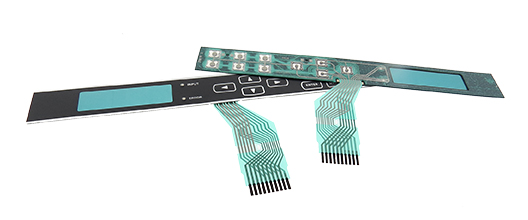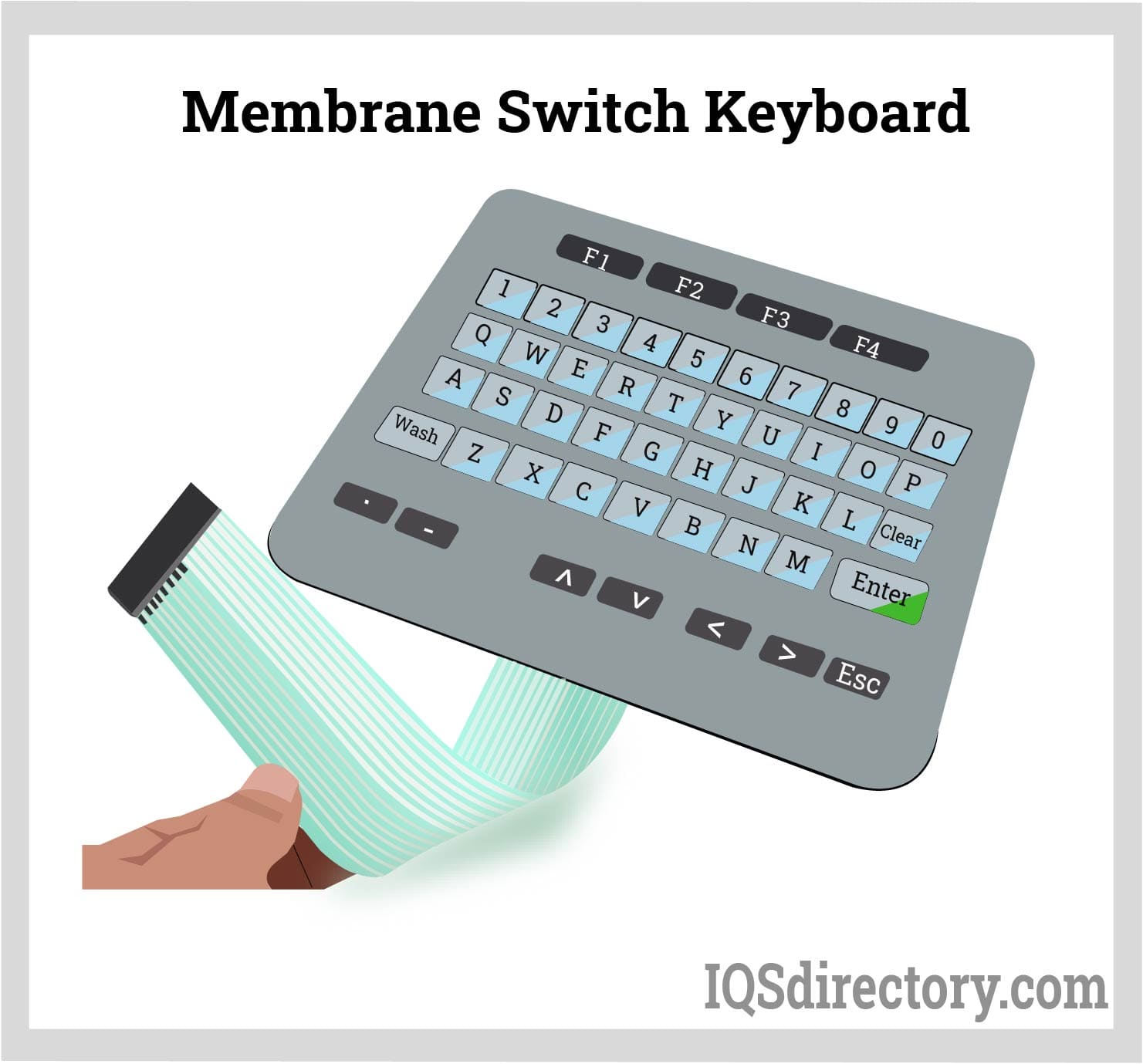The Production Process Behind Membrane Layer Change: What You Need to Know
The production process behind membrane switches combines mindful style, product choice, and quality assurance. It starts with comprehending the details of membrane button design and advances through numerous stages, consisting of product options and printing techniques. Each stage plays a vital function in guaranteeing performance and sturdiness. The complexities of layer building and the rigorous screening standards may reveal understandings that are not quickly evident. What lies past these foundational aspects?
Understanding Membrane Layer Change Style
Membrane buttons might appear basic at very first look, their layout involves elaborate considerations that guarantee performance and resilience. The design process begins with a thorough understanding of customer needs, including the user interface's designated application and environmental variables. Ergonomics is a crucial element, as the format needs to facilitate convenience of usage while guaranteeing that tactile responses fulfills individual expectations.Moreover, the layering of parts, such as visuals overlays, sticky layers, and conductive traces, need to be exactly crafted. membrane switch. This layered arrangement not just affects the button's responsiveness yet likewise influences its durability. Focus is offered to the sealing methods utilized to secure against moisture and dirt, which might jeopardize performance. Furthermore, design considerations reach aesthetics, where color pattern and visual quality enhance individual experience. Eventually, the design of membrane changes equilibriums functionality, user experience, and sturdiness, making certain that they meet the needs of numerous applications successfully
Materials Made Use Of in Membrane Layer Change Manufacturing
When choosing materials for membrane button manufacturing, it is necessary to consider both performance and durability. The key products consist of polyester and polycarbonate movies, which give versatility and strength. These films are frequently covered with glue to ensure correct bonding to substrates. Conductive inks, normally composed of silver or carbon, are essential for creating electric links within the switch, permitting trustworthy operation.Additionally, a protective layer, such as a tough coat, is frequently related to enhance scrape resistance and durability. The choice of backing product, such as acrylic or foam, can considerably impact the switch's responsive feel and overall individual experience. Numerous ecological variables, including temperature and moisture, ought to lead material choice to ensure peak efficiency in details applications. Ultimately, the right combination of materials adds to the membrane layer switch's capability and lifespan, making informed choices vital for producers.
The Printing Process: Creating Graphics and Text
The printing procedure in membrane layer button manufacturing plays a significant duty in creating top quality graphics and message. Numerous visuals layout methods are used to assure visual allure and capability, while cautious ink selection approaches are necessary for toughness and performance. Comprehending these components is basic for achieving ideal results in membrane switch layout.
Graphic Layout Techniques
Graphic style strategies play an essential duty in the printing procedure of membrane buttons, as they specify just how graphics and text will inevitably show up on the final product. Reliable visuals style involves the critical usage of formats, font styles, and shades to enhance readability and aesthetic appeal. Developers frequently make use of vector graphics for scalability, guaranteeing that photos remain sharp at numerous sizes. Furthermore, focus to contrast and placement is vital, as it affects customer interaction and visual quality. The consolidation of branding components, such as logos, should be taken care of with like preserve brand name integrity. In general, thoughtful visuals layout techniques contribute substantially to the functionality and beauty of membrane layer buttons, impacting individual experience and item efficiency.
Ink Option Methods
Choosing the proper ink is essential for achieving the preferred aesthetic top quality and durability in membrane switch manufacturing. Different ink kinds are made use of, consisting of solvent-based, water-based, and UV-curable inks. Each kind supplies distinctive qualities, such as versatility, resistance, and adhesion to environmental factors. Solvent-based inks are frequently favored for their longevity and vivid shades, while water-based inks are much more eco-friendly however might have restrictions in bond. UV-curable inks give rapid curing and robust efficiency. Additionally, shade matching strategies guarantee that the picked inks align with design specs. Inevitably, the choice of ink need to think about factors such as application technique, substratum compatibility, and end-use demands to attain premium lead to membrane switch graphics and text.
Layer Construction and Setting Up

Product Option Refine
A mindful option of materials is vital in the manufacturing procedure of membrane buttons, as it directly influences performance and toughness. The key products made use of consist of polyester, polycarbonate, and various conductive inks. Polyester is commonly preferred for its outstanding resistance to chemicals and abrasion, making it ideal for harsh atmospheres. Polycarbonate, on the various other hand, supplies remarkable quality and effect resistance, which is helpful for applications calling for exposure and toughness. Conductive inks, typically composed of silver or carbon, are essential for producing trustworthy electrical pathways. Additionally, the choice of sticky materials impacts the overall stability of the button - membrane switch. Reviewing variables such as environmental exposure, tactile responses, and aesthetic demands overviews producers in selecting the very best products for their details applications
Layer Bond Techniques
Sticking layers in membrane layer switch building and construction is an essential process that assures capability and durability. Various bond techniques are used to protect perfect bonding in between layers, which normally include the use of adhesives, warmth, and pressure. Pressure-sensitive adhesives (PSAs) are commonly used for their ease of application and prompt bonding capabilities. In addition, thermal bonding techniques can be used, where heat is used to trigger adhesive properties, protecting a solid bond. The option of attachment technique mainly depends on the products entailed and the certain application demands of the membrane layer switch. Appropriate alignment and uniform application of adhesives are essential to stop issues, safeguarding the switch runs effectively throughout its designated life-span.
Quality Assurance Steps
Assuring quality assurance during the layer building and construction and assembly of membrane buttons is crucial for maintaining performance and dependability. This procedure generally includes a number of essential procedures, consisting of comprehensive assessments at each phase of manufacturing. Suppliers utilize advanced testing techniques, such as peel examinations and bond assessments, to confirm the stability of layer bonds. Furthermore, aesthetic examinations are performed to recognize any kind of defects in printing or material inconsistencies. Environmental problems, such as temperature level and humidity, are very carefully kept an eye on to ensure suitable healing and attachment. Routine calibration of devices helps maintain specific production requirements. By applying these top quality control procedures, makers can considerably minimize the risk of product failing, ensuring that the final membrane switches over fulfill the called for requirements and customer expectations.
Testing and Quality Control Procedures

Technologies in Membrane Switch Over Innovation
As developments in modern technology proceed to develop, membrane buttons are taking advantage of cutting-edge advancements that enhance their capability and individual experience. One noteworthy innovation is the assimilation of capacitive touch innovation, which permits for more intuitive and responsive user interfaces. This change not just enhances visual appeals but additionally decreases mechanical damage, prolonging the life-span of the switches.Additionally, developments in visuals overlay materials have actually led to enhanced durability and resistance to ecological aspects such as dampness and UV light. These materials currently offer improved quality and brightness, additional boosting the visual appeal.Furthermore, the consolidation of clever technology is transforming membrane switches over right into interactive control panels, allowing connection with IoT devices. This connectivity promotes a smooth customer experience, leading the way for applications in numerous industries, from health care to customer electronics. Jointly, these developments setting membrane layer switches as crucial components in contemporary tool layout.
Often Asked Concerns
Just how Lengthy Does the Membrane Switch Manufacturing Process Take?
The duration of the membrane switch manufacturing procedure can differ substantially. Variables such as intricacy, products used, and production volume impact timelines, with typical production ranging from a couple of days to several weeks for conclusion.
What Are the Usual Applications for Membrane Layer Buttons?
Membrane layer buttons are generally made use of in numerous sectors, consisting of vehicle controls, family home appliances, clinical gadgets, and consumer electronics (membrane switch). Their versatility and resilience make them perfect for applications requiring user-friendly interfaces and reliable efficiency in varied atmospheres
Can Membrane Switches Be Custom-made for Details Requirements?

What Is the Life expectancy of a Normal Membrane Layer Switch?
The lifespan of a common membrane layer button differs, yet usually, it ranges from 1 to 5 million cycles. Factors such as usage, environment, and material high quality considerably affect longevity and total efficiency over time.

Are Membrane Switches Eco-friendly?
The ecological friendliness of membrane layer advice changes varies. Some products made use of might not be recyclable, while others can be environment-friendly. The general impact depends on making techniques and materials, demanding cautious consideration throughout choice and disposal. The manufacturing procedure behind membrane layer switches combines careful layout, material selection, and top quality control. It begins with understanding the details of membrane layer switch layout and advances through numerous stages, consisting of material choices and printing methods. When selecting products for membrane button manufacturing, it is important to ponder both performance and durability. A mindful selection of products is important in the production process of membrane layer switches, as it straight influences performance and resilience. The selection of adhesion approach largely depends on the products involved and the certain application requirements of the membrane button.